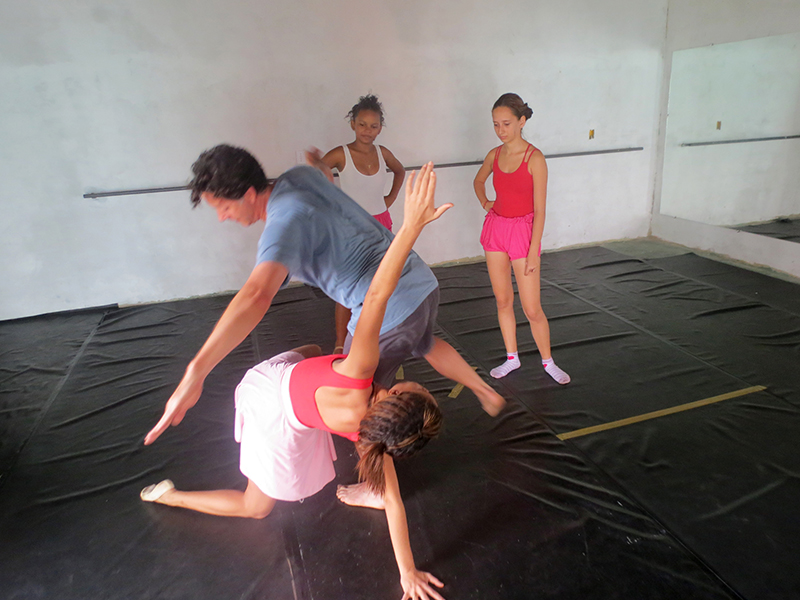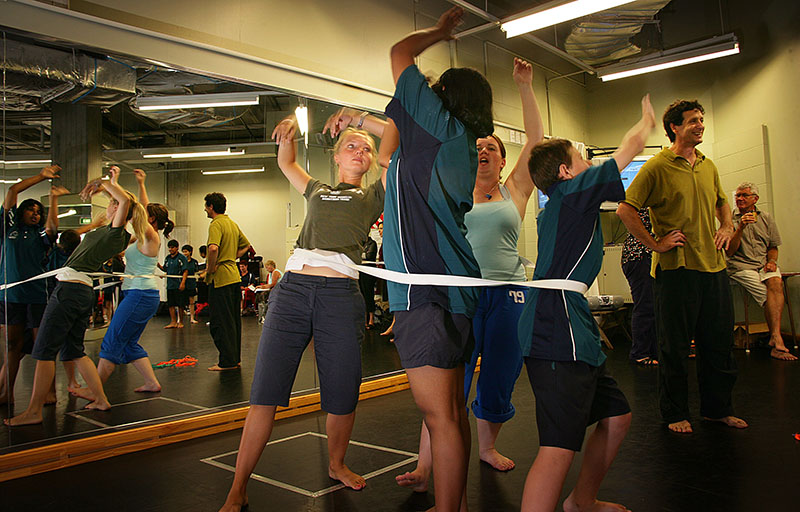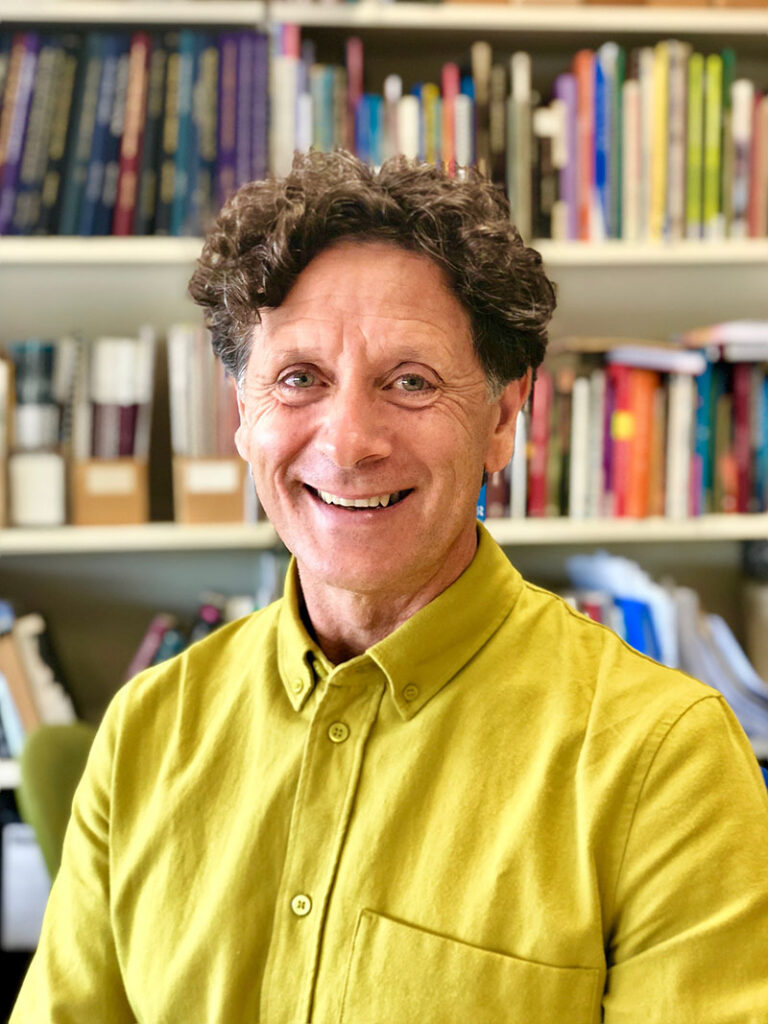Dance as a Medium to Access Different Communities
An Interview with Associate Professor Ralph Buck
BY EMMALY WIEDERHOLT
Associate Professor Ralph Buck is the Head of Dance Studies at the University of Auckland, a post he has held since 2005 when he overhauled the department. Here, he explains how he transformed the program from a conservatory model into a community-oriented pedagogical approach that challenges dance’s role in the world. Dr. Buck is also UNESCO’s first Co-Chair on Dance and Social Inclusion. Through this work and other international research, he shares how his educational philosophy is being applied within a global context.
Note: This essay was first published in Stance on Dance’s fall/winter 2022 print issue. To learn more, visit stanceondance.com/print-publication.

Photo by Dan Baron Cohen
~~
Can you tell me a little about your dance history and what shaped who you are as an artist today?
I’m a teacher. That’s my entry into dance. It was not through art, but through education. My childhood was working on a farm in rural Australia. My first degree was a Bachelor of Physical Education and Health, and I got into working with kids with special needs. I used rhythm and movement. That eventually led me to playing with dance, but not really dancing.
My first introduction to dance was when I was in New Zealand in 1986 managing a sports recreation center. I wanted a new challenge, so I went to a ballet class. I was 26 years old. The next day, my muscles were extremely sore. I thought that was unusual, because at the time I was very fit from doing basketball, gymnastics, and hockey. So I went again to figure out what was happening that was making me so tired. I stayed there for a year doing ballet and contemporary.
My teachers eventually told me, “You’ve got the body, you can remember the moves, you have no injuries, you’re a male, do you want to be a professional dancer?” I didn’t want to be a performer; my career is in education, so instead I focused on dance education.
I went to the University of Surrey in England and did my thesis on dance education for adults with Down syndrome. Then I moved back to Australia and worked in a special needs school for children with severe behavior problems. I used dance as my way to connect with kids. From there I was invited to write the dance curriculum for primary and secondary schools in Queensland and Australia. I worked with teachers throughout the state to implement the curriculum and develop resources.
I moved to New Zealand to do my PhD in Dance Education at the University of Otago. I studied dance in primary schools and teachers’ perspectives. And from there I moved to the University of Auckland as head of the department and created a new dance degree and vision of dance.
In all of that, I did perform. I danced with a mixed abilities dance company in London called Amici Dance Theatre Company. And when I was studying dance at the University of Surrey, I was in a lot of productions because I was one of the few males. When I was writing the curriculum in Queensland, I asked a local contemporary dance company if I could join for six months in order to get an artistic perspective. That was informative because I was doing dance classes for the first half of the day and writing curriculum for the second half. I performed for one season and confirmed in my mind and body that I don’t want to be a performer. I love improvisation within the classroom, the constant thinking, reinvention, and hurly burly . For me it’s the ultimate performance.
When you first arrived at the Dance Studies program at The University of Auckland in 2005, what was the program like and why did you want to shift it toward a liberal arts model with community engagement?
Before I arrived, it was a struggling and small degree. It was “Let’s learn to be ballet, tap, and contemporary dancers,” a conservatory program with a bit of theory on the side. I had no interest in that idea. When I took the job, I said to the dean I needed free range to change the curriculum and I needed budgetary independence. I was very bold.
We’re in New Zealand. We have a strong and vibrant Indigenous and Pacific Islander cultural framework, and yet no university program in New Zealand was making Māori or Pacific Islander dance part of a dance degree. I reoriented several courses to include Māori and Pacific Islander dance as part of the core curriculum. I focused on community engagement and pedagogy. I spoke to a lot of young people and asked where they want to go in dance. I decided we needed to make a degree that would support diverse careers and visions.
The degree I created has vertical modules and horizontal connections. The vertical modules include: dance education and community dance; choreography; dance vocabulary; culture and history; and professional well-being (including business and marketing). As a student progresses through the three-year degree, the horizontal threads or connections between the vertical modules are made in terms of careers, student strengths and interests, community opportunities, and transdisciplinary connections.
I want students to understand their place in dance history. Rather than learning about Martha Graham, they reference their personal history, family history, and community history, and how/if that intersects with Martha Graham. I turned the tables around to ask: What’s relevant to young students in New Zealand? What research directions should we take? What issues do we need to understand? Consequently, we’ve had a lot of research focused on community dance education, how we take dance into communities, how we serve communities, what communities want, how we improve education, the best way to teach young people, the best way to teach old people, etc.
So that’s what we do. From the first year of undergraduate to the end of a PhD, research informs all our teaching, and we take everything we do out into the community in various ways.

Photo courtesy Creative Arts and Industries, University of Auckland Marketing Department
What was the process like shifting the Dance Studies program toward a liberal arts model?
A key part was when I said to my dean, “I need financial independence.” I did not want the dance department subsumed into a music, drama, or PE department. I wanted the dance department to stand by itself. I didn’t want dance to be a second thought. At the time, there were very few dance programs that I knew of around the world that were financially independent. They were always protected by a bigger discipline. I’m very proud of the fact that I’ve been here for 18 years and the department has never made a loss. Right now, we’ve got the largest PhD cohort in the world. When I started, I was the only staff member, and now there are nine full-time staff members.
How is the Dance Studies curriculum informed by the student population, especially given that a significant number of the students at the University of Auckland are Māori or Pacific Islander?
We have a large population of Māori and Pacific Islander students, and we invite that diversity comfortably. We understand that the history of a student who comes from a Māori context is radically different than a student coming from a white European context. The key point I want my students to understand is that one is not better than the other; they are just two different histories, each with their own complexities. To get those young people to open up and talk confidently about their histories and aspirations has been a challenge, but once they understand that their history, culture, and aspirations have a place and are valued, they more comfortably turn up, participate, and engage.
It comes back to the idea that you can invite diversity, but if you don’t make it work, there’s no point in going through the charade. You’ve got to figure out how to actually be more inclusive. That requires a different type of thinking. All our staff have had to get on board with being more empathetic, tolerant of difference, and questioning of bias. That’s hard for some people, but thankfully we as a staff are very tight. At the heart of everything we do are these core values and aspirations.
I understand the Dance Studies program has an extensive community engagement component. As an overview, what is the department’s intersection with the community?
The best example is the second-year course called community dance, which is designed to take the students out into the community. We go to a secondary school and teach kids with special needs, we go to a hospital and teach kids in the psych unit, we go to a retirement village and teach the elderly with dementia, and we go to refugee centers and teach refugees. As the teacher, I model how to teach, and my students act as co-teachers and are given tasks to conduct in small groups. By the end of that course, the students are familiar with various strategies to work with different communities. They develop an awareness that they have knowledge, skills, and abilities that are of value in specific contexts. Consequently, there are careers down the road where retirement villages, for example, employ our students to offer dance.
In the third year, we go back into a classroom and my university students design and deliver six weeks of lessons. My students have to go out and be the teacher. They find it really hard. It’s a difficult thing for them to get their head around, but that’s the job. I explain to them, you can be the world’s best performer, but the way you’re going to consistently pay the bills is more often than not through teaching.
What are your main areas of research and study?
I’ve just published a book called Dance Pedagogy and Education in China. It’s a personal narrative of me teaching dance to a group of tertiary students at the Beijing Dance Academy. I describe the importance of teaching in dance, about dance, and through dance if we’re going to value dance in wider contexts. “In dance” refers to learning choreography and steps. “About dance” is dance in culture, history, and society. “Through dance” is how we can develop 21st century competencies through dance. When you use those three little words – in, about and through – you see the potential dance has because you’re looking at dance with a broader lens. In China, students are too often conditioned to just focus on becoming the best dancer. Dance equates with excellence; if you’re not an excellent dancer, then why are you studying dance? My role as a visiting guest professor has been to shift the pedagogy, to shift career assumptions and expectations, and to shift the way students see themselves in that industry.
My most recent research is following up on a UNESCO report that asked “What’s going on in your discipline and how is your discipline going to change in the future?” I accepted that challenge and travelled to different parts of Australia interviewing secondary school teachers and dance educators, asking them, “What is the future relevance of dance education?”
In this COVID world where so much of our learning and teaching has been online, I wanted to know how that has shaped dance education and training. The relevance of dance is about the physical experience of being in front of other people, learning to work with other people, and reading other people in a room. A dominant finding is that a lot of kids are very shy to do that. For example, many of my current third years who have done their whole tertiary education during COVID are missing these specific skills. They lack that sense of turning up with physical confidence.
One of the things the teachers in Australia noted is the impact of social media and TV, where dance is portrayed as short, sharp, and extreme/fantastic/ridiculous. TV shows are all competitions that are lampooning or championing dance with an exaggerated skill set. All these exaggerated virtual performances may be causing kids to not want to perform. They say, “I’ll make a video of myself, but I don’t want to show up.” They don’t want to present their bodies. Social media and TV have defined performance in a particular way, and they can’t compete with it. It’s this whole skill/body/attitude shaming that’s happening through platforms like TikTok and Instagram. Everything has become product oriented, and process has fallen by the wayside.
Alongside your colleague Nicholas Rowe, you’ve been named UNESCO’s first co-chairs on Dance and Social Inclusion. What does that entail?
We’re conducting critical studies in leadership and inclusion. We investigate how dance can foster well-being through political, social, and cultural inclusion and sustainable development. An example would be how we’re doing dance research with elderly who have dementia or working with youth in socioeconomically challenging situations. We also look at the role of dance in political contexts: Nicholas’ particular interest is the role of dance in Palestine and developing community consciousness through dance. Another thing we do is transnational education. We build partnerships with universities in different countries. We’ve been working closely with several universities in China. We’re also fostering social inclusion with Asia-Pacific dance networks by supporting symposiums and conferences. Another key factor is my role in the World Dance Alliance and World Alliance for Arts Education. These professional organizations connect communities with larger global networks like UNESCO.
Being a UNESCO co-chair is especially important in advocating for dance in all its diversity across the globe. UNESCO is important, as countries in the developing world, which is the vast population of the planet, look to UNESCO for political and civic guidance. It’s a bit of a trip: Here I am in my comfortable office in New Zealand, trying to work in partnership with various people around the world, but ultimately not affecting that much. I think I’m failing beautifully in changing the world. But I’m trying.
Any other thoughts?
I’m increasingly thinking about dance as social, cultural, and political infrastructure. It’s like building highways, where I see dance as a medium to access different communities. Traveling on that highway can lead to diverse people and careers, as well as exciting intersections with other ways of thinking like physics, history, health science, languages, etc. As dance educators and artists, I feel we need to remember that such disciplines need dance as much as we need them. That transdisciplinary aspect is quite important, without losing the essential role of dance, which is moving the body and moving the brain. Since being at University of Auckland, my motto has been, “Move your thinking.”

Photo courtesy Creative Arts and Industries, University of Auckland Marketing Department
~~
Note: This essay was first published in Stance on Dance’s fall/winter 2022 print issue. To learn more, visit stanceondance.com/print-publication.

2 Responses to “Dance as a Medium to Access Different Communities”
Thanks Rick! Glad to hear the article resonates:)
Awesome article. As a handicapped former dancer, who works as an arts administrator at a major dance nonprofit in San Francisco, so much of what you talk about, resonates, for me.
Comments are closed.